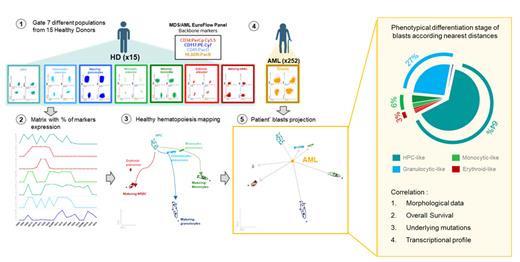Background: The identification of the nearest normal counterpart of blasts has been part of the patients' diagnostic workup and contributed to the sub-classification of AML. While there is a progressive displacement of morphologically defined AML subtypes by those with recurrent genetic abnormalities, recent studies in younger patients eligible for intensive chemotherapy suggested that a phenotypic sub-classification of AML might be prognostic. However, an antigen-based assessment of blast differentiation is in part complex and subjective, and to our knowledge has not been systematically investigated in elderly AML.
Aim: Develop a data-driven approach to facilitate and systematize the phenotypic dissection of older AML patients ineligible to receive intensive chemotherapy.
Methods: The study included 252 patients (>65yo) that were randomized to azacitidine vs low-dose Ara-C plus fludarabine in the PETHEMA-FLUGAZA trial. MFC was performed using the EuroFlow AML panel in bone marrow aspirates. The percentage of expression of each marker in hematopoietic progenitor cells (HPC), granulocytic, monocytic and erythroid precursors, as well as in maturing granulocytes, monocytes and nucleated red blood cells (NRBC) was determined in 15 healthy adults. The data were merged and a matrix was obtained for each subject. The percentage of expression of each marker was determined in patients' blasts. After projecting each case onto the matrix generated from healthy adults, the distance between blasts and normal populations was calculated, and the shortest distance identified the corresponding differentiation stage. Blasts were isolated according to patient-specific aberrant phenotypes for DNA and RNA co-isolation and subsequent next-generation sequencing (n=179/252) and RNA-seq (n=190/252).
Results: Of the 252 patients, 64% were classified with an HPC-like AML phenotype, 27% a granulocytic-precursor, 2% monocytic-precursor, 2% erythroid-precursors, <1% maturing-granulocytic, 4% maturing-monocytic and <1% maturing-NRBC. Cell types from the same lineage were regrouped into granulocytic-, monocytic and erythroid-like AML. Overall, there was a 46% concordance between phenotypic and FAB classification. Interestingly, patients classified as HPC-like AML treated with azacitidine (and not those receiving semi-intensive chemotherapy) showed slightly longer overall survival when compared to those with maturing AML subtypes.
We next investigated the relationship between phenotypically-defined stages of blast arrest and the presence of underlying mutations. Interestingly, there was scarce overlap in the top three recurrently mutated genes across the HPC- ( SRSF2, TET2, RUNX1), granulocytic- ( ASXL1, FLT3, TET2), monocytic ( FLT3, NF1, TET2), and erythroid-like ( TP53, DNMT3A, NF1) AML subtypes. Conversely, EPAS1, FLT3 and NF1 were more frequently mutated ( p<.05) in erythroid- and monocytic- vs HPC-like AML. Amongst the maturing subtypes, monocytic-like AML was characterized by frequent SH2B3 and absent TP53 mutations ( p<.05).
The comparison between HPC-like vs all maturing subtypes identified several deregulated genes associated with different stages of hematopoiesis (i.e., HOXA3, ANKRD28, CLEC2B, HSD17B11, SYPL1, HBD, S100A8, ITGAM). Granulocytic-like AML patients showed deregulation of 200 genes; 44 of which were upregulated and enriched in granulocytic-related pathways. Only 23 genes were deregulated upon comparing the transcriptional profile of HPC- vs monocytic-like blasts. A total of 415 genes were deregulated between HPC- and erythroid-like blats; 269 of which being overexpressed and associated with pathways such as transferrin transport, erythrocyte development and differentiation. Accordingly, the transcriptional profile of blasts corroborated our data-driven approach.
Conclusions: This study builds upon recent interest in non-genetic drivers of AML heterogeneity and classification systems based on the partial recapitulation of myeloid development, and shows that these concepts may be applied in elderly patients. Our proof-of-concept data-driven approach has the potential to be incorporated into flow cytometry analytical software towards a more objective dissection of AML subtypes based on blast differentiation, which could potentially yield prognostic information complementary to other routine diagnostic procedures.
Disclosures
Martinez-Cuadron:Pfizer: Other: Travel, Accommodations; Astellas: Consultancy, Speakers Bureau; Otsuka: Consultancy, Other: Travel, Accommodations. Bergua Burgues:Fundesalud. Grants of Europena funds.Daychii: Research Funding; Hospital San Pedro de Alcántara. Servicio de Hematologia. Cáceres. SPAIN: Current Employment; Daychii: Consultancy. Tormo:Pfizer: Honoraria; Astellas: Honoraria; AbbVie: Honoraria; MSD: Honoraria; BMS: Honoraria. Lavilla:Sanofi, Janssen, Incyte, SOBI; Belgene: Consultancy, Honoraria. Ayala:Novartis: Consultancy, Speakers Bureau; Incyte: Consultancy; Astellas, BMS: Speakers Bureau. San Miguel:Takeda: Consultancy, Honoraria, Membership on an entity's Board of Directors or advisory committees; Novartis: Consultancy, Honoraria; MSD: Consultancy, Honoraria, Membership on an entity's Board of Directors or advisory committees; Janssen: Consultancy, Honoraria; Celgene: Consultancy, Honoraria, Membership on an entity's Board of Directors or advisory committees; BMS: Consultancy, Honoraria, Membership on an entity's Board of Directors or advisory committees; Amgen: Consultancy, Honoraria, Membership on an entity's Board of Directors or advisory committees; Sanofi: Consultancy, Honoraria, Membership on an entity's Board of Directors or advisory committees; Roche: Consultancy, Honoraria, Membership on an entity's Board of Directors or advisory committees; Pfizer: Consultancy, Honoraria, Membership on an entity's Board of Directors or advisory committees; GSK: Consultancy, Honoraria, Membership on an entity's Board of Directors or advisory committees; Karyopharm: Consultancy, Honoraria, Membership on an entity's Board of Directors or advisory committees; Haemalogix: Consultancy, Honoraria, Membership on an entity's Board of Directors or advisory committees; Abbvie: Consultancy, Honoraria, Membership on an entity's Board of Directors or advisory committees; SecuraBio: Consultancy, Honoraria, Membership on an entity's Board of Directors or advisory committees; Regeneron: Consultancy, Honoraria, Membership on an entity's Board of Directors or advisory committees. Montesinos:Novartis: Consultancy, Research Funding; OTSUKA: Consultancy; Kura oncology: Consultancy; BEIGENE: Consultancy; GILEAD: Consultancy; Takeda: Consultancy, Research Funding; Menarini-Stemline: Consultancy, Research Funding; Jazz pharma: Consultancy, Research Funding, Speakers Bureau; Abbvie: Consultancy, Research Funding, Speakers Bureau; Janssen: Speakers Bureau; BMS: Consultancy, Other, Research Funding; Pfizer: Consultancy, Research Funding, Speakers Bureau; Ryvu: Consultancy; Astellas: Consultancy, Speakers Bureau; NERVIANO: Consultancy; Celgene: Consultancy; INCYTE: Consultancy; Daiichi Sankyo: Consultancy, Research Funding. Paiva:Roche Glycart AG: Honoraria, Research Funding; Adaptive: Honoraria; Bristol-Myers Squibb: Consultancy, Honoraria, Research Funding; Janssen: Consultancy, Honoraria; Sanofi: Consultancy, Honoraria, Research Funding; EngMab: Research Funding; GSK: Honoraria, Research Funding; Takeda: Honoraria, Research Funding; Amgen: Honoraria; Gilead: Honoraria; Oncopeptides: Honoraria.


This feature is available to Subscribers Only
Sign In or Create an Account Close Modal